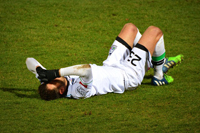 Here’s rule number one for managing injuries whether you’re running a youth soccer team, high school football or a rugby team: Don’t even run a practice game unless somebody on hand is trained in first aid.
Here’s rule number one for managing injuries whether you’re running a youth soccer team, high school football or a rugby team: Don’t even run a practice game unless somebody on hand is trained in first aid.
The easiest way to handle this: Get trained in first aid, or, if someone else manages or coaches the team, have them get training. Now there will always be somebody on hand who knows what to do in the event of an injury.
If you run a sports team for any length of time, injuries are a given. Athletes are going to pull a leg muscle, take a fall or sprain a wrist now and then. Immediate, informed response to these injuries can make the difference between your star player being out for the season, or back on the field in a week. Not only that, it can make the difference between how big of a claim you need to make on your sports team insurance.
- Learn to Identify Concussions
The most immediately recognizable symptoms of a concussion include headache, loss of consciousness, confusion, balance problems, nausea and dizziness. You can check for a concussion by looking at your athlete’s eyes. If the pupils are of unequal size or if they stay dilated (larger) no matter their exposure to light, then you may be dealing with a concussion. Get them to an emergency room as soon as possible, and make sure that they stay awake.
- Muscular Injuries
Dealing with muscular injuries is, thankfully, not as complicated as dealing with a broken bone. If a player complains of difficulty or discomfort moving an arm or a leg, look for swelling or redness, and make sure they stay comfortable until you can get them medical attention.
- Bone Fractures
A broken arm or leg always looks a lot scarier than it really is. With proper medical attention, broken limbs can heal up as good as new within a few months, but you need to act fast. Make sure the athlete stays awake, use smelling salts if you need to. It’s best not to move them, but if you need to get them out of harm’s way, do it carefully. Don’t worry about setting up a splint or anything. You’re not lost in the woods, that’s the paramedics’ job.
- Cuts and Scrapes
Disinfect, clean and bandage cuts and scrapes. Even if it’s going to need stitches, cleaning the area right away is important. Most cuts you can shake off with a band-aid and some ointment. Others may require a visit to the doctor’s office. Keep a first-aid kit on hand and be glad that cuts are pretty easy to manage.
Not only will basic first aid keep your team safe, it will also keep football team insurance premiums low by reducing the number and severity of adult or youth sports insurance claims you need to make.





